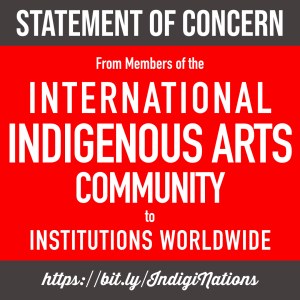Art Gallery of Ontario versus Freedom of Speech and Palestine Solidarity: The Silencing of Wanda Nanibush
Statement of Concern from Members of the International Indigenous Arts Community
“Decolonizing museums should not be left to the handful of Indigenous people that work in museums. It’s like it’s piled on, do my job and then decolonize the museum as well, … it’s got to be the whole institution. It has to be the people who think it’s not their job.” — Lucy Bell (Haida), APTN, April 2021
Canada’s public art institutions have reversed course on their much lauded, highly publicized and commodified commitments toward decolonization and Indigenization.

Cultural practices are the lifeblood of our Indigenous communities. Our cultural world and creative practices extend back to our very origins across our lands and bring us to this day and into tomorrow, beyond the current moment of colonialism in which we find ourselves. We continue to endure systematic oppression strategized through settler colonial aspirations, worldwide. Our practices, powerful and central to articulating our relation to one another and the land, have been targeted, commodified and suppressed. We have been dispossessed of our languages, lands, life-sustaining resources and ceremonial objects which are vital to our cultural continuance, intellectual economies and systems of revitalization. We have been omitted from art history canons, underrepresented in galleries, and all that was stolen from our communities is exhibited and stored in private collections and museums around the world.
Indigeneity is marked by settler colonial violence and oppression, both historical and contemporary. Given this inheritance, our capacity for pattern recognition allows us to acknowledge our shared circumstances and intersectionality with global Indigenous populations. We have no time to excuse the suffering of those we recognize as our own.
In 2017, the Art Gallery of Ontario (AGO) created a highly publicized, newly renamed “Department of Canadian and Indigenous Art,” hiring their first Indigenous curator – Anishnaabekwe artist, curator and word warrior, Wanda Nanibush. We emphasize “word warrior” because Wanda was hired by the AGO with this being an integral component of her biography and professional reputation, and it’s not an aspect of her character or commitment that should have ever been a surprise to the institution. She has a gifted ability to beautifully articulate and communicate her Nishnaabekwe thoughts and ways of knowing the world through her writing.
We were both impressed and wary of the heavy level of responsibility of this newly created position. And yet we watched as Nanibush quickly moved into her new role: simultaneously launching Rebecca Belmore’s solo exhibition, Facing the Monumental, while at the same time, bringing together a global gathering of Indigenous artists, curators and academics for the first aabaakwad (it clears after a storm) symposium in the Fall of 2018. During her tenure she oversaw several renditions of aabaakwad symposiums, all of which fostered generative discussions and established international relationships among global communities and collaborations continuing to this day.
So, you can imagine our dismay at Nanibush’s notably silent departure which many of us haphazardly learned of only through a social media post alerting the public that the Art Gallery of Ontario had scrubbed her professional biography from their website. This decision to erase Nanibush’s institutional presence happened without the usual media fanfare upon which the AGO has built its international “decolonizing and Indigenizing” reputation, while bolstering gallery membership and attendance through Wanda Nanibush’s work and name. We see the statements being made by AGO Director Stephan Jost in response to the media’s repeated questions as devoid of meaningful engagement with the issues at hand, providing inadequate context for the public’s understanding of what is happening.
Who does this silence and misdirection protect?
Is this respectful and/or decolonial behavior?
This departure follows Lucy Bell (Haida), Head of Indigenous Collection and Repatriation Department, who stepped down from the Royal British Columbia Museum and Archives (RBCM) in 2020 due to admitted, “acts of racism and discrimination at the museum, with Indigenous team members subjected to acts of discriminatory behaviour.” Shortly after, Troy Sebastian (Ktunaxa), Curator, Indigenous Collection, also left the RBCM at the end of his contract, after publicly calling for change. A report written by the RBCM Board of Directors in June 2021 stated, “The whole Museum must be reimagined and decolonized to ensure that we do better as we work to earn back the confidence and trust of those who were made to feel unsafe, excluded, isolated, or unwanted.”
In November 2022, Kanyen’keháka artist and curator Greg Hill was also dismissed from the National Gallery of Canada (NGC) with little transparency from the NGC save for a statement from the interim director and CEO who said they, “needed to look at how [they] can do things differently and move away from traditional ways of working that are no longer reflective of the kind of institution we need and want to be.”
Three weeks ago, Galleries Westquoted the new Director of the National Gallery of Canada, Jean-Francois Bélisle, as blatantly stating,
“I think there’s a way to make our society better, make our galleries better, which is the part where I’m concerned – is making the gallery better. But what is decolonization? What would it entail? I’m not even sure I’m interested in thinking about it. I’m interested in building something, not de-building it.”
It’s appalling to us that the NGC, situated on unceded Algonquin territory, has chosen Bélisle to lead the gallery into the future. His comments reflect an abject failure on behalf of the institution and flies directly in the face of the Truth and Reconciliation Commission’s Calls to Action for Museums and Archives (2015) and the National Inquiry for Missing and Murdered Indigenous Women and Girls’ Calls for Justice (2019).
The harms inflicted upon our community members working in these institutions MUST CEASE. A requirement of employment should not entail facing regular systemic discrimination, racism and subsequent stress-related obstacles. Though we’ve only cited a few cases where Indigenous arts workers have been pushed out of institutions, we know there are MANY MORE. We are concerned about the safety and security of colonized people working in public institutions worldwide.
We are calling for a genuine response from the Art Gallery of Ontario and a public acknowledgement of the departure of their first Indigenous Curator in the Indigenous and Canadian Art Department and of Wanda Nanibush’s contributions to the International art world and meaningful engagement with issues of Indigeneity and decolonization during her tenure with the AGO.
We call upon all institutions in Canada and worldwide to acknowledge the precarious labour positions of Indigenous peoples by instituting policies which ensures us the constitutionally protected freedom to speak about our experiences and understandings of settler colonialism, violence, and injustice and/or engage in activism and dialogues pertaining to our communities and shared concerns, values and ways of being. This includes protections for social media accounts which we rely upon as spaces of digital resistance, inter-community connections, collaborations and sharing of thoughts and information – on an international scale. In spaces where they’ve taken our livelihoods, we have found each other in order to survive.
Globally, we call upon galleries, museums, artist-run-centres, academic institutions, and arts organizations to review and revise the inner workings and cultures of their institutions and to genuinely support and commit to practiced policies of decolonization and Indigenization. •
In Global Solidarity,
- Aylan Couchie, Interdisciplinary Artist/Writer/Curator, PhD Candidate, Nipissing First Nation
- Biung Ismahasan, Bunun, Atayal and Kanakanavu Nations of Taiwan Indigenous Peoples, Curator/Community Facilitator/Assistant Researcher (Professor) in Indigenous Art and Curatorial Practice, Center for General Education / Chief for Section of Extracurricular Activities, Office of Student Affairs, National Chi Nan University, TAIWAN
- Michelle Sylliboy, Interdisciplinary Artist, Mi’kmaq Nation
- Monique Mojica, Theatre Artist/Author, Guna and Rappahannock … complete list
Open Letter to the Art Gallery of Ontario
Dear Stephan Jost,
We, the undersigned artists, writers, curators, and cultural workers, write to express outrage at the recent push out of Wanda Nanibush from her position as the inaugural curator of Indigenous Art at the Art Gallery of Ontario, following the bullying of the museum by pro-Israel art collectors and donors. As members of the public, we are stakeholders in the AGO and adamantly hold the institution to its commitments to diversity, equity, inclusion and accessibility, which include the need to host difficult conversations about reconciliation, locally and internationally.

It is clear from a letter authored by members of Israel Museums and Arts, Canada (IMAAC), and leaked to the public, that pro-Israel donors and supporters of the AGO pressured the museum’s director and board of directors into silencing Nanibush’s ongoing efforts to educate people about Palestinians and their fight for freedom – and her condemnation of what the United Nations has warned is a “genocide in the making” by Israeli forces – which ultimately led to her departure from the institution. The letter openly admits this is not the first time its signatories have attempted to intimidate the museum’s administration to punish Nanibush for her expressions of solidarity with Palestinians. Within the last few years, it is clear that there are privately funded bodies monitoring the actions of arts institutions and lobbying to publicly defund organizations that critique the actions of the state of Israel and/or organizations that support the actions of the state of Israel. Using a definition of antisemitism that has been widely condemned by Jewish scholars and by activists in an appeal to the United Nations, the letter describes Nanibush’s posts on social media in deeply condescending and colonialist tones. The letter also makes disturbing comparisons between a critique of the Israeli government and antisemitism, and invokes imagined acts of transphobia that tokenizes violence against trans and gender-diverse individuals as justification for silencing an Indigenous curator. Anti-Zionism is not antisemitism. We reject these conflations.
Nanibush’s departure from the AGO has been shrouded in mystery, despite the gallery celebrating her many achievements in curating groundbreaking and award-winning exhibitions by First Nations, Inuit, Métis, and international Indigenous artists, and her role in re-organizing the institution’s Indigenous and Canadian art collections as a nation-to-nation agreement. Her forced resignation from the museum came to light only through the determined work of a group of audience members and investigative reporters: further evidence that museum administration hoped to obscure the conditions of her departure to maintain the façade of reconciliation while quietly silencing the work of Indigenous leaders.
We demand that the AGO:
- Release a statement detailing how the museum plans to continue the important educational and curatorial work that Nanibush achieved in her 7 years at the institution as the inaugural Curator of Indigenous Art, and how they will recommit to the project of reconciliation and the calls to action laid out in the Truth and Reconciliation Commission Report;
- Adopt a policy respecting and defending the freedom of expression of its staff and curators – including freedom of expression related to Palestine – made publicly available on its website;
- Provide a public accounting of how AGO board members were involved in the ousting of Nanibush and request the resignation of those responsible for her departure;
- Develop a process of accountability that explains how AGO leadership will handle future pressures from donors and patrons.
Until the AGO meets these four demands, we pledge to boycott the institution. This includes:
- cancelling all memberships with and annual passes to the AGO;
- refusing to participate in any exhibitions, programs, public talks, film screenings or events at, organized by, affiliated with, or promoted by the AGO;
- not opening newsletters from, or content produced by, the AGO, nor circulating it online.
Additionally, we commit to holding accountable the institutions run by the signatories of the letter authored by IMAAC who have undemocratically sought to censor cultural workers at a public institution supported by municipal, provincial and federal government funders. This includes unsubscribing from newsletters sent by the Art Canada Institute, directed by Sara Angel, and refusing to purchase, read or teach from ACI publications; and refusing to participate in nor attend events, auctions, exhibitions or talks organized by Caviar20, directed by Troy Seidman.
As practitioners, educators, audience members and vital stakeholders of this publicly funded institution, we expect much more from the AGO. •

Letter to the AGO Board of Directors
Dear AGO Board of Directors,
We the undersigned cultural workers, scholars, and concerned Ontario residents write to convey to the Board our indignation over the sudden departure of Wanda Nanibush as curator of Indigenous Art and co-lead of the J.S. McLean Centre for Indigenous & Canadian Art at the Art Gallery of Ontario.
Ms. Nanibush’s leadership and commitment to Indigenizing and decolonizing the practices at the AGO have enabled innovation in governance and exhibition-making. The AGO’s director has confirmed this stating, “Her curatorial achievements strengthened the AGO’s reputation globally, fostering a new way of collaborating and working together. Wanda’s innovation has truly been monumental”. Evidence of Ms. Nanibush’s radical re-imagining of the gallery has been swiftly erased. The wall panels that articulate the nation-to-nation relations at the gallery have been removed leaving no sign of Nanibush’s work on Indigenous sovereignty. This is particularly concerning as the AGO and other arts and cultural institutions have committed to advance towards Truth and Reconciliation.
A leaked letter to the AGO Board of Directors signed by members of the Israel Museums and Arts, Canada suggests that there have been ongoing attempts to silence and censor Ms. Nanibush’s support for the Palestinian peoples’ struggle for human rights, justice, and freedom. Since Nanibush’s departure on November 16, 2023, there has been silence on the part of the Board, and a lack of transparency regarding the process and role of the Board in precipitating Ms. Nanibush’s departure.
We ask that the AGO Board commit to freedom of speech, artistic freedom, equity, and social justice. We also call for the following:
- A public statement from the AGO Board of Directors to the community regarding your role in the departure of Ms. Nanibush,
- Your commitment to refrain from adopting the IHRA definition of antisemitism, which many Jewish and Israeli organizations argue serves to weaponize antisemitism and target advocates for Palestinian human rights,
- Your commitment to advancing the Calls to Action outlined by the Truth and Reconciliation Commission Report. •
Sincerely,
Andrea Fatona
Richard Fung
Luis Jacob
Deb Cowen, and others
44 Governor General Award Winners Protest Forced Departure of Wanda Nanibush from AGO
In an open letter released 28 November, 44 recipients of Governor General’s Awards in Visual and Media Arts condemn the forced departure of Curator Indigenous Art Wanda Nanibush from the Art Gallery of Ontario last week.
After noting her outstanding accomplishments, they call her exit “shocking.” Their letter states: “The forced departure of Wanda Nanibush is an act of political censorship with shades of a new McCarthyism.”
Co-signators are drawn from coast-to-coast, and include such celebrated artists as Ruth Cuthand, Paul Wong, Jamelie Hassan, Vera Frenkel, Robert Houle, Louise Déry, Jayce Salloum, Cheryl L’Hirondelle, Deanna Bowen, Carole Condé and Karl Beveridge.
Dear members of the Board of Directors and CEO/Director of the Art Gallery of Ontario,
We, recipients of Governor General’s Awards in Visual and Media Arts from across the country, are writing to express our alarm and disapproval of the forced departure of Wanda Nanibush, Curator Indigenous Art, and co-head of the Indigenous and Canadian Art Department at the AGO.
The AGO’s own public statements of Wanda Nanibush’s extraordinary accomplishments and all she has brought to building relations with Indigenous artists and communities, makes her exit shocking.
The forced departure of Wanda Nanibush is an act of political censorship with shades of a new McCarthyism. It undermines principles of artistic freedom and freedom of speech. It also reveals a shallowness to the AGO’s supposed commitment to reconciliation, decolonization, and justice for Indigenous people, and to social justice more generally.
Wanda Nanibush’s forced departure severely damages the reputation and credibility of the AGO and sets a dangerous precedent in Canadian art that demands protest. •






